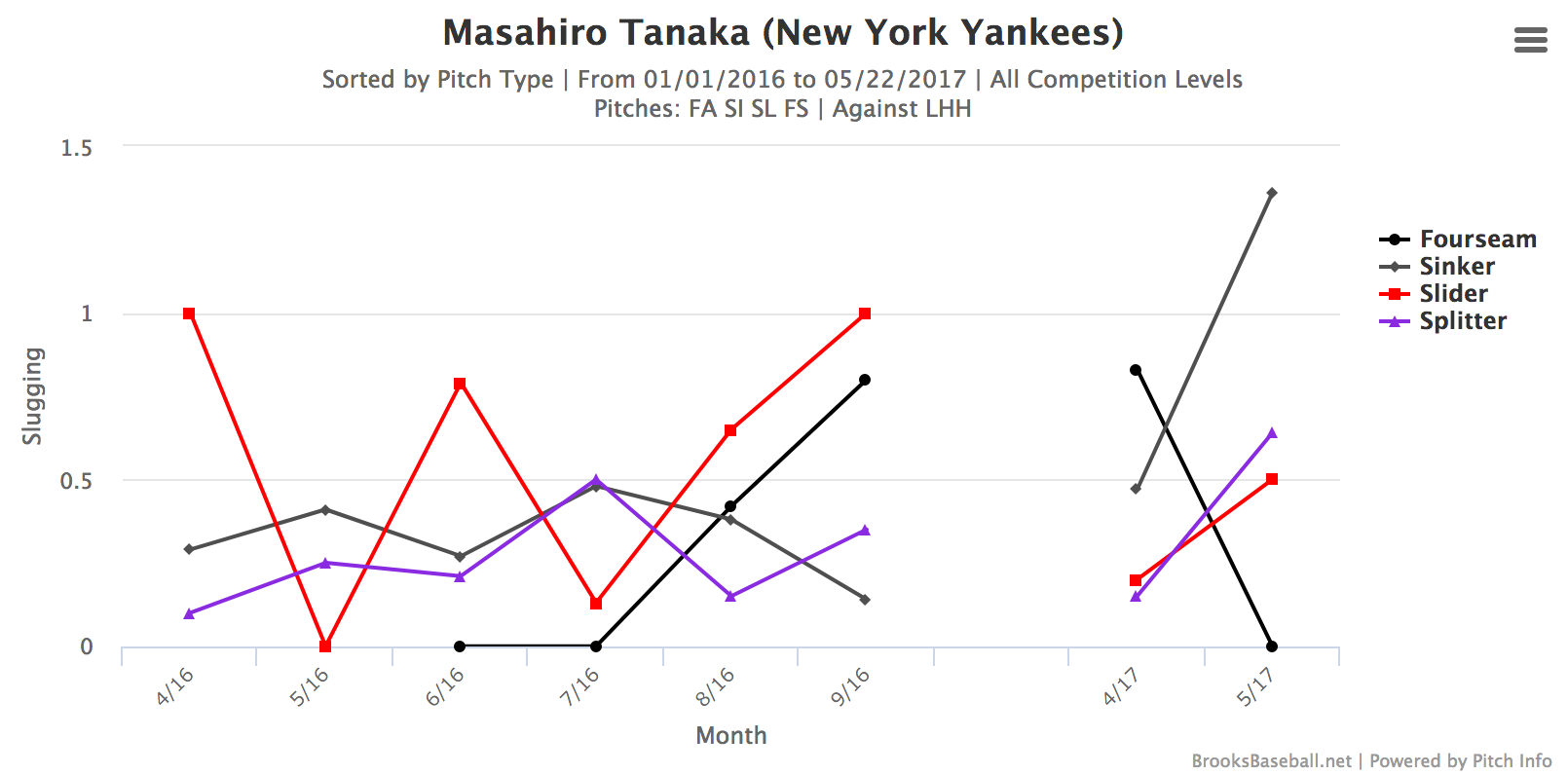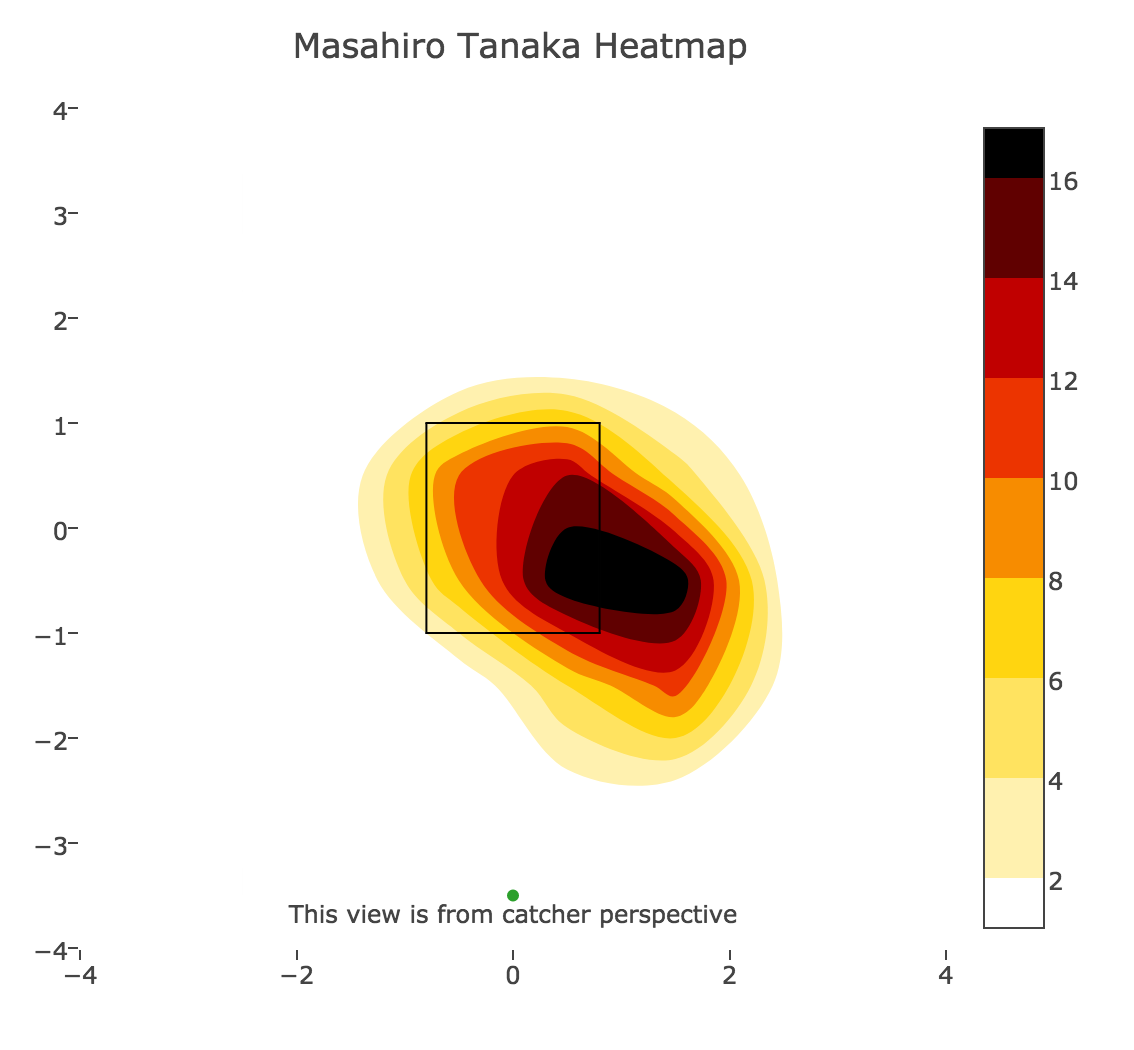What’s Wrong with Tanaka?
So much is going well for the Yankees. Aaron Judge has exceeded everyone’s expectations. Aaron Hicks has found another level. Top prospect Gleyber Torres has been promoted to Triple-A. Luis Severino has a 21.1-point K-BB% mark. Michael Pineda owns an even better 24.5-point K-BB% mark — and finally has some better BABIP luck to go with his elite swing-and-miss stuff. Many believe, including this author, that it’s better than even odds that we will see Bryce Harper somewhere in the Yankee outfield in 2019. If feels like the next Yankee dynasty is taking shape.
But not everything is going well. Aroldis Chapman is hurt and the club’s greatest investment on the current roster, Masahiro Tanaka, isn’t pitching like the top-of-the-rotation arm that his established levels and contract suggests he would be. Tanaka was supposed to bridge the last Yankees’ core to the next. He’s owed $22 million the next two seasons and $23 million in 2019.
Said Yankees manager Joe Girardi to MLB.com after Tanaka’s latest rough outing Saturday:
“We know that he has to make adjustments, and that’s where our focus is,” Yankees manager Joe Girardi said. “This guy’s got a really good track record. He’s had a lot of success here, so it’s not like he’s just coming over from Japan and struggling. He’s in a rut now, and we think we’ve discovered a few things that will help him and will continue to help him.”
So what’s going on?
This spring in Florida I was asked to be the “stats guy” for a documentary on Tanaka being filmed by a Japanese studio. I met with the film crew and interviewer at a hotel room in Bradenton, Florida, in March. They wanted me to explore via my laptop — and on camera — what allowed Tanaka to be successful at the major-league level. Tanaka has used location, a variety of pitches, and movement to succeed in the majors despite lacking elite velocity.
The film crew had relayed to me that Tanaka said he was trying to rely less on his four-seam fastball and become more of a sinker-slider-splitter pitcher to survive in the cramped AL East ballparks. Tanaka has been hurt by home runs and he did move away from the four-seamer last season, throwing a splitter on a career-high 30.2% of offerings and a slider at a career-best rate 27.5%. Only about 6% of his pitches were classified by PITCHf/x as four-seam fastballs. This season, though, his splitter and slider usage is down. He’s had a history of elbow issues.
This season, just about everything is trending in the wrong direction for Tanaka. Consider his slugging versus pitch type by month over the last two seasons:

He’s getting crushed by lefties (.352 wOBA), but he’s being hit even more forcefully by righties (.411).
Tanaka’s trouble appears to be twofold: he’s relying less on his two best pitchers — his slider and splitter — decreasing their combined usage from 58% last year to 47%. He’s throwing his four-seam fastball more. And he’s not locating as well with his fastball and splitter.
Consider Tanaka’s four-seam fastball location versus lefties to date in 2017:

And his four-seam fastball location against righties in 2017:

Tanaka has 24.3% home-run rate per fly ball (HR/FB), and he’s already allowed three home runs off his four-seam fastball, a pitch he didn’t throw often last season. The pitch has merely average velocity and spin, and he cannot afford to miss with it.
Tanaka’s preferred fastball has become the two-seam/sinker. Consider its location versus righties in 2016, when he was able to move it around the strike zone:

And his two-seam/sinker location against righties to date in 2017:

A year ago, Tanaka was able to pitch to the glove- and arm-side parts of the plate, seemingly at will, with the pitch. This season, he has too often left the pitch over the heart of the plate. And even when Tanaka just slightly misses with location, he can be hurt by his home ballpark.
When examining Tanaka’s two-seamer/sinker versus lefties in 2016 he was able most often locate it on the outside edge and at the lower extreme part of the zone:

Tanaka doesn’t appear to be missing badly with the pitch, but he’s more often pitching in the zone — and particularly down in the zone — in 2017:

And finally, consider Tanaka’s signature, pitch, his splitter, to lefties in 2016:

Compare that visual to his work to date in 2017. You can see the pitch is leaking more out over the plate:

Too often the splitter isn’t splitting. The pitch is flattening out and catching more plate than Tanaka can afford.
Said Yankees pitching coach Larry Rothschild to MLB.com: “It doesn’t look like there’s anything with the arm. Sometimes location can be part of the problem, but that’s not what he’s saying. There’s no indication of [an injury].”
And if there were an injury, it’s not showing up in velocity. He’s hit 97 mph this year, his highest reading since 2014, and his two-seam/sinker velocity (91.0 mph) is slightly up from last season.
Here’s what scouts are saying according to the N.Y. Post.
“When spring training ended he looked like he was back to before the injury,’’ said a scout who watched the Rays pummel Tanaka for six runs and nine hits (three homers) in a 9-5 loss Saturday. “Now he doesn’t look the same.’ …
“He isn’t finishing his pitches, and he’s making mistakes with the fastball,’’ said another scout at Tropicana Field over the weekend.”
It’s still early. There’s no public suggestion of injury. The velocity is still there for Tanaka. But Tanaka has less margin for error than, say, a Pineda or Severino. And the Yankees need another top-of-the-rotation arm to hold on in the AL East and hope to make a deep push into the postseason. The Yankees are paying Tanaka to be that arm. If he cannot be, they might have to decide whether to pay more in terms of dollars and prospects to find and fill the need. But the good news is Tanaka might not be off by that much.
A Cleveland native, FanGraphs writer Travis Sawchik is the author of the New York Times bestselling book, Big Data Baseball. He also contributes to The Athletic Cleveland, and has written for the Pittsburgh Tribune-Review, among other outlets. Follow him on Twitter @Travis_Sawchik.

I thought he’d go the same route as Iwakuma. Great at managing contact and below average strikeout rates. This season he’s gone full Dice K though. You never go FULL Dice K.